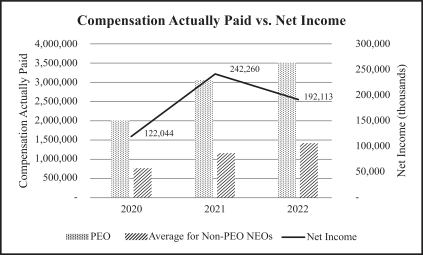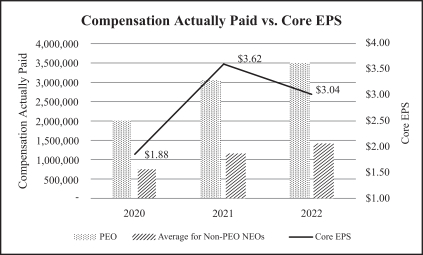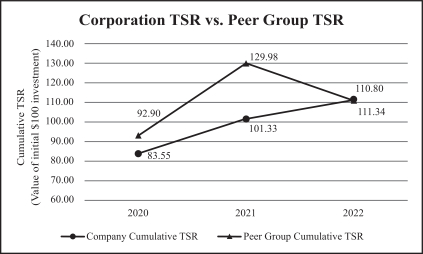| | | | | | | | | | |
 | | | | | | 
|
| |
| Your vote matters – here’s how to vote!
You may vote online or by phone instead of mailing this card.
|
| | |  | | Votes submitted electronically must be received by 1:00 a.m., Eastern Time, on April 19, 2023.Wheeling, West Virginia
|
| | | 
| | Online
Go to www.investorvote.com/WSBC or scan the QR code – login details are located in the shaded bar below.
|
| | March 13, 2024 | 
| | Phone
Call toll free 1-800-652-VOTE (8683) within the USA, US territories and Canada
|
| | | | | | | | | | |
| | | | | |
Using a black ink pen, mark your votes with an X as shown in this example.
Please do not write outside the designated areas.
| |  | | | |  | | | | Save paper, time and money!
Sign up for electronic delivery at www.investorvote.com/WSBC
|
| | |
|

q IF VOTING BY MAIL, SIGN, DETACH AND RETURN THE BOTTOM PORTION IN THE ENCLOSED ENVELOPE. q
|
---------------------------------------------------------------------------------------------------------------------------------------------------------------------------------------
| | | | | | | | |
| | |
A | | Proposals – The Board of Directors recommend a vote FOR all the nominees listed, FOR Proposals 2, 4, and 5 and 1 YEAR on Proposal 3. | | |
| | | | | | | | | | | | | | | | | | | | | | | | | | | | | | |
| | 1.
| | To elect six persons to the Board of Directors to serve for a term of three years expiring at the annual stockholders meeting in 2026: | | | | | | | | | | 
| | |
| | | | | | | | | | | | | | | | | | | | | | | | |
| | | | | | For | | Withhold | | | | | | For | | Withhold | | | | For | | Withhold | | |
| | | 01 - Todd F. Clossin
| | ☐ | | ☐ | | 02 - Michael J. Crawford
| | | | ☐ | | ☐ | | 03 - Abigail M. Feinknopf
| | ☐ | | ☐ | | |
| | | 04 - Denise Knouse-Snyder
| | ☐
| | ☐
| | 05 - Jay T. McCamic
| | | | ☐
| | ☐
| | 06 - F. Eric Nelson, Jr. | | ☐
| | ☐
| | |
| | | | | | | | | | | | | | | | | | | | | | | | | | | | | | |
| | | | | | | | For | | Against | | Abstain | | | | | | | | 1 Year | | 2 Years | | 3 Years | | Abstain | | | | |
| | | | | | | | | | | | | | |
| | 2.
| | To approve an advisory (non-binding) vote on compensation paid to Wesbanco’s named executive officers. | | | | ☐ | | ☐ | | ☐ | | | | 3. To approve an advisory (non-binding) vote on the frequency of future advisory votes on executive compensation.
| | ☐ | | ☐ | | ☐ | | ☐ | | | | |
| | | | | | | | | | | | | | |
| | | | | | | | | | | | | | | | | | | | For | | Against | | Abstain | | | | |
| | | | | | | | | | | | | | |
| | 4.
| | To approve an advisory (non-binding) vote ratifying the appointment of Ernst & Young, LLP as our independent registered public accounting firm for the fiscal year ending December 31, 2023. | | | | ☐ | | ☐ | | ☐ | | | | 5. To consider and act upon such other matters as may properly come before the meeting or any adjournment thereof.
| | | | ☐ | | ☐ | | ☐ | | | | |
| | | | | | | | | | | | | | | | | | | | | | | | | | | | | | |
| | | | | | | | | | | | | | | | | | | | | | | | | | | | | | |
| | |
B | | Authorized Signatures – This section must be completed for your vote to be counted. – Date and Sign Below |
(
WESBANCO, INC.
AMENDED AND RESTATED
INCENTIVE BONUS, OPTION AND RESTRICTED STOCK PLAN
WESBANCO, INC.
AMENDED AND RESTATED
INCENTIVE BONUS, OPTION AND RESTRICTED STOCK PLAN
INTRODUCTION
The purposes of the Wesbanco, Inc. Amended and Restated Incentive Bonus, Option and Restricted Stock Plan are to enhance shareholder value and to contribute to the growth of Wesbanco, Inc., its subsidiaries and affiliates by:
1. directing the planning, implementation and supervisory efforts of Key Executives toward the achievement of strategic, financial and individual goals determined by the Board of Directors of the Company to be in the best interests of the Company and its shareholders over annual and multi-year planning cycles;
2. requiring Key Executives and Non-Employee Directors to position the Company, in light of changing business conditions and the Company's business plans, to succeed over annual and multi-year business horizons;
3. placing a significant portion of the compensation of Key Executives at risk in the event Performance Goals are not met and, thereby, provide substantial incentive to achieve annual and longer term goals;
4. identifying the interests of Key Executives and Non-Employee Directors more closely with those of shareholders by denominating compensation at least in part in Shares of Common Stock and options to purchase Shares of Common Stock; and
5. providing the Company with a flexible compensation arrangement to use as a tool to attract and retain Key Executives and Non-Employee Directors of outstanding competence.
The Plan is designed to accomplish its purposes by providing financial rewards to Key Executives if, but only if, pre-established financial and/or personal goals, which may include completion of specified periods of employment, are achieved. Non-Employee Directors are eligible to receive grants of nonqualified options and will be rewarded if the trading price for the Common Stock increases after the date the nonqualified option is granted.
For Key Executives:
The Plan has four portions for Key Executives: an Annual Bonus Portion, a Long Term Bonus Portion, a Stock Option Portion and a Restricted Stock Portion. The Annual Bonus Portion offers Participants opportunities for Incentive Compensation generally denominated in cash, based on the degree of attainment of corporate and/or personal goals over one fiscal year. The Long Term Bonus Portion offers Participants opportunities for Incentive Compensation denominated, generally in cash and Shares of Common Stock, based on the degree of attainment of corporate and/or personal goals over more than one fiscal year. The Stock Option Portion permits the Compensation Committee to award options which will become vested, if at all, based on attainment of performance goals or the completion of a specified period of employment. The Restricted Stock Portion permits the Compensation Committee to award shares of Common Stock subject to restrictions that will lapse, if at all, upon the attainment of performance and/or personal goals or the completion of a specified period of employment.
Participation in any portion of the Plan will be limited to those executive level employees of the Company (including in that term executive level employees of any subsidiary of the Company) who are in a position to directly influence the achievement of goals set by the Board. The Plan is not intended to be a broad based arrangement. Further, in recognition that certain executives may be in a position to have more influence over attainment of certain goals, the Plan does not require that all Performance Goals or Performance Levels be uniform for all Key Executives. In addition, in recognition that certain executives may be able to influence the outcome of certain goals set for a particular Fiscal Year but not for a period longer than a Fiscal Year, a Key Executive may be made eligible for an Annual Bonus but not for a Long Term Bonus and/or Stock Options or, in the alternative, for a Long Term Bonus, Stock Options or Restricted Stock but not an Annual Bonus. Inclusion in one portion of the Plan or for any one year is no assurance of future eligibility by a particular Key Executive for any other portion or any other year or Incentive Cycle. Accordingly, opportunities to earn Incentive Compensation as well as the individual and collective goals to be met to realize Incentive Compensation, as Annual Bonus or Long Term Bonus or to vest Stock Options or Restricted Stock under the Plan, may vary from Key Executive to Key Executive.
The Annual Bonus Portion focuses on the business plan for the next Fiscal Year and sets goals to be achieved in that Fiscal Year. If the goals are met, Incentive Compensation for the Annual Bonus portion is paid primarily in cash. On the other hand, Long Term Bonus focuses on the business plan over several successive Fiscal Years. If goals are met over the measurement period, Long Term Bonus is paid in the form of a combination of stock and cash.
The number of years under consideration for a Long Term Bonus is referred to as an "Incentive Cycle". It is intended that an Incentive Cycle will be formed each year for the number of years for which a reasonably thorough business plan can be prepared. At the adoption of the Plan, the appropriate number of years to be included in an Incentive Cycle is believed to be three but the Plan allows the Compensation Committee to elect, in its discretion exercised at the formation of each Incentive Cycle, to include more or fewer years in an Incentive Cycle.
For the Long Term Bonus Portion, Incentive Compensation is denominated as a "Unit", that is, the basic unit of Incentive Compensation expressed in terms of dollars and whole or fractional Shares. Moreover, at the adoption of the Plan, it is believed that the appropriate composition of each Unit should be a combination of Shares and cash so that any income tax obligations of Key Executives in connection with the Plan may be settled without resort to sale of Shares.
Stock Options are granted at the discretion of the Compensation Committee, each with an exercise price equal to the then fair market value of a share of Common Stock. The Compensation Committee shall set a vesting schedule with vesting in years following the grant of the Stock Option based upon continuation of employment for that year or attainment in each such year of performance goals set for that year under the Annual Bonus Plan (or if no Annual Bonus Plan is in effect for that year, performance goals set specifically for the Stock Option Portion.)
Restricted Stock is granted at the discretion of the Compensation Committee. The Compensation Committee shall set as a vesting schedule, attainment of performance goals and/or continuous employment over a period of years specified in the granting documents.
The Board of Directors, in consultation with management and in connection with the Company's ongoing business planning processes, will direct which goals are to be achieved over the ensuing Fiscal Year for purposes of the Annual Bonus, Stock Option and Restricted Stock Portions and for the longer Incentive Cycle for purposes of the Long Term Bonus. The Compensation Committee will determine and set the following to be consistent with the Board's directions:
(a) Performance Goals appropriate to the Board's directions;
(b) the composition of Units used to denominate Incentive Compensation opportunities for the Long Term Bonus;
(c) Threshold, Target and Superior levels of achievement with respect to Performance Goals for the Annual and Long Term Bonus, respectively;
(d) Incentive Compensation, expressed in Units for Long term Bonus and dollars for Annual Bonus, which may be distributed to each Key Executive, in the event Threshold, Target or Superior Performance Levels are achieved; and
(e) whether Stock Options will be granted in that year and, if so, in what amount and to what Key Employees.
The Compensation Committee will then communicate with the Key Executive and cause the execution and delivery of such documents as may be required to implement the Plan for the Fiscal Year for Annual Bonus, Restricted Stock and Stock Option purposes and the Incentive Cycle for Long Term Bonus purposes.
At or after (but not more than seventy five days after) the end of a particular Fiscal Year and/or an Incentive Cycle, the Compensation Committee, after review of financial and other information appropriate to determining whether Performance Goals have been met for that Fiscal Year or Incentive Cycle, including, but not limited to, extraordinary items and/or special circumstances, and taking such other actions as the Compensation Committee shall deem appropriate, will:
(a) determine the level of actual achievement of Performance Goals, taking into account, to the extent the Committee deems appropriate in its sole judgment, extraordinary items and/or special circumstances which affected or may have affected the ability of one or more of the Key Executives to achieve one or more of the Performance Goals;
(b) determine the Incentive Compensation, if any, to be distributed to each Key Executive participating in the Plan as Annual Bonus for a particular Fiscal Year or Long Term Bonus for that Incentive Cycle and the vesting, if any, with respect to any previously granted Stock Options or Restricted Stock; and
(c) direct the commencement of installment distributions of Incentive Compensation which may have been earned under the Plan as Long Term Bonus with respect to that Incentive Cycle.
To accommodate the changing nature of the Company's business and the adjustments to business objectives from year to year, as well as to provide continuous incentive to achieve those objectives and to offset the effects of business anomalies, the Long Term Bonus Portion is designed to form a new Incentive Cycle each year and to have that Incentive Cycle overlap with the Incentive Cycles for the preceding and subsequent years. Each Incentive Cycle, if formed, will be formed independently of any other Incentive Cycle and Incentive Compensation for any Incentive Cycle will be determined with respect to only that Incentive Cycle. In this regard, the rolling three year Incentive Cycles are intended as a complement to the Annual Bonus portion of this Plan.
Incentive Compensation for both the Annual Bonus and the Long Term Bonus will be determined by the Compensation Committee within seventy-five (75) days of the end of that Incentive Cycle. Incentive Compensation earned as Annual Bonus will be paid in a single sum as soon as practicable after its determination. Incentive Compensation earned with respect to a particular Incentive Cycle will be distributed in three (3) substantially equal annual installments. The payment of Incentive Compensation and of each installment is contingent upon a Key Employee's being an employee of the Company on the date of distribution, except if the cessation of employment is related to death, disability or retirement of that Key Employee.
Stock Options, to the extent vested and exercisable, can be exercised in accordance with the terms and conditions set forth in the stock option agreement which evidences those Stock Options. Restricted Stock will become vested on the terms and conditions set forth by the Compensation Committee at the time of grant.
For Non-Employee Directors:
The Plan has two features for Non-Employee Directors. The Plan permits the Compensation Committee to grant Stock Options and/or shares of Restricted Stock to Non-Employee Directors. Grants of Stock Options to Non-Employee Directors may vest based on a period of continuous service on the Board. Restrictions on shares of Restricted Stock may lapse based on a period of Continuous Service on the Board.
Administrative Delegation:
In order to facilitate the administration of the Plan, the Plan contemplates that the Compensation Committee may delegate ministerial functions, such as preparation of documents and notices, withholding for required taxes and delivery of distributions authorized under the Plan, to such members of the management of the Company as the Compensation Committee shall deem appropriate.
The foregoing Introduction is included in this Plan document for descriptive purposes only and the Plan's provisions which follow shall control over the Introduction. As used in the Introduction, initially capitalized terms shall have the meanings assigned thereto under the Plan.
ARTICLE I
DEFINITIONS
1.1 "Annual Bonus" shall mean the amount of Incentive Compensation which may be earned by a particular eligible Key Executive based on performance for a particular Fiscal Year.
1.2 "Cause" shall mean a Key Executive's (i) conviction for a felony (or of a lesser included offense following indictment and entry of a guilty plea), (ii) continued failure, after thirty (30) days written notice from the Company, to render service to the Company as required under the terms and conditions of his or her employment or (iii) persistent negligence and dereliction of duty which shall include, but shall not be limited to, the Key Executive's frequent failure to perform properly assigned tasks or violation of the Company's drug and alcohol policies.
1.3 "Beneficiary" shall mean the person or persons a Key Executive has designated by filing an election with the Administrative Committee, substantially in the form of Schedule A attached hereto to receive his or her Incentive Compensation, to the
extent payable, in the event of his or her death. If no Beneficiary has been designated, or if a Key Executive's Beneficiary has predeceased the Key Executive, the Key Executive's spouse or, if none, the Key Executive's children perstirpes, or, if none, the Key Executive's estate, shall be deemed to be the Key Executive's Beneficiary.
1.4 "Board of Directors" or "Board" shall mean the Board of Directors of Wesbanco, Inc.
1.5 "Common Stock" shall mean common stock, par value $2.0833 per share, of Wesbanco, Inc.
1.6 "Company" shall mean Wesbanco, Inc., a West Virginia corporation, its subsidiaries, and the affiliates, subsidiaries, successors and assigns of the Company.
1.7 "Compensation Committee" or "Committee" shall mean the Compensation Committee of the Board of Directors of Wesbanco, Inc., provided, however, no member of the Compensation Committee who is or at any time during the then past year has been a Key Executive or is then under consideration to become a Key Executive shall be permitted to participate in the discussion of or vote on his or her participation in the Plan or any Incentive Compensation which he or she may receive hereunder or to assist in the administration of the Plan and to the extent necessary to supplement the foregoing, each member of the Compensation Committee eligible to participate in the administration of this Plan shall be a "disinterested person" within the meaning of Section 16b-3 of the Securities Exchange Act of 1934, as amended, and the regulations promulgated thereunder, and provided, further, participation by such person, directly or indirectly, in the preparation or review of all or any portion of the Company's business plan, analysis or forecast shall not be regarded as participating in a discussion or voting on Incentive Compensation under the Plan.
1.8 "Disability" shall mean the inability of a Key Employee due to mental or physical defect or disease to perform the services required of the Key Employee in the position he or she held prior to the manifestation of that defect or disease.
1.9 "Fair Market Value" shall mean, as of a relevant date, the reported closing price of a share of Common Stock on the business day immediately preceding that date.
1.10 "Fiscal Year" shall mean the twelve month period used by the Company for financial reporting purposes which, as of the date of adoption hereof, is the calendar year.
1.11 "Good Reason" shall mean, without the Key Employee’s express written consent:
(a) the assignment of the Key Employee to duties materially inconsistent with the Key Employee’s authorities, duties, responsibilities, and status (including offices, titles and reporting requirements) as an officer of the Company or its principal subsidiary, Wesbanco Bank, Inc., or a reduction or an alteration in the nature and status of the Key Employee’s authorities, duties, or responsibilities from those in effect as of ninety days prior to the Change in Control event, other than an insubstantial and inadvertent act that is remedied by the Company promptly after receipt of notice thereof given by the Key Employee, and other than any such alteration which is consented to by the Key Employee in writing;
(b) the Company’s requiring the Key Employee to be based in a location in excess of thirty-five miles from the location of the Key Employee’s principal job location or office immediately prior to the Change in Control event, except for required travel on the Company’s business to an extent substantially consistent with the Key Employee’s present business obligations;
(c) a reduction by the Company of the Key Employee’s Base Salary by at least ten percent from that in effect immediately prior to that reduction;
(d) the failure of the Company to obtain a satisfactory agreement from any successor to the Company to assume and agree to perform the Company’s obligations under any employment agreement to which the Key Employee and the Company or Wesbanco Bank, Inc. is a party; and
(e) any purported termination by the Company which is not accomplished by written notice setting forth the basis for that termination or, if the Key Employee is a party to an employment agreement setting forth a specific procedure for termination of employment, such notice does not comply with the applicable provisions of that employment agreement.
The Key Employee’s right to terminate employment for Good Reason shall not be affected by the Key Employee’s incapacity due to physical or mental illness. The Key Employee’s continued employment shall not constitute consent to, or a waiver of rights with respect to, any circumstance constituting Good Reason.
1.12 "Incentive Compensation" shall mean the distribution, if any, a Key Executive is or may become entitled to receive under the terms of this Plan as Long Term Bonus for a particular Incentive Cycle, Performance Levels for performance based Restricted Stock and/or Annual Bonus for a Fiscal Year.
1.13 "Incentive Cycle" shall mean the number of Fiscal Years over which an opportunity to earn Long Term Bonus will be measured. At the adoption of the Plan, the number of Fiscal Years deemed appropriate is three (3) but the Compensation Committee may include more or fewer years at the formation of a particular Incentive Cycle.
1.14 "Key Executives" shall mean those employees of the Company who, with respect to a particular Plan Year, are deemed to hold positions which may substantially influence the attainment of Performance Goals. Employees designated as Key Employees for the Annual Bonus and/or Long Term Bonus purposes, may or may not, in the discretion of the Committee be eligible to earn Incentive Compensation under the other portions of this Plan and may or may not be eligible to earn Incentive Compensation in future years under any portion of this Plan.
1.15 "Long Term Bonus" shall mean the amount of Incentive Compensation which may be earned by a particular eligible Key Employee for a particular Incentive Cycle.
1.16 “Non-Employee Director” shall mean a member of the Board who is not then and has not been for a period of one year prior to the relevant time an employee of the Company.
1.17 "Plan" shall mean this Amended and Restated Wesbanco, Inc. Key Executive Bonus, Stock Option and Restricted Stock Plan, as in effect from time to time and as interpreted and/or administratively supplemented by the Compensation Committee under the terms of this Plan from time to time.
1.18 "Performance Goals" shall mean those goals, described in terms of financial results, operational achievements or individual objectives, or any combination thereof, to be achieved for Annual Bonus purposes, over a particular Fiscal Year or for Long Term Bonus purposes, over a particular Incentive Cycle, as may be set by the Compensation Committee to implement the Board's directions for that Fiscal year or Incentive Cycle, respectively. For the Option Portion and Restricted Stock Portion, “Performance Goals” may also include periods of continuous employment.
1.19 "Performance Levels" shall mean the relative level of achievement of Performance Goals. Performance Levels shall be set as Threshold for acceptable performance, Target for meeting expectations and Maximum for exceeding expectations.
1.20 “Restricted Stock” shall mean shares of Common Stock awarded to a Participant subject to certain restrictions as determined by the Compensation Committee at the time of grant. A Participant receiving a grant of Restricted Stock shall not be a shareholder with respect to those shares of Restricted Stock unless or until the Restricted Stock vests in accordance with the terms of the grant, except that, if shares of Restricted Stock vest, the Participant may be paid an amount of cash equal to dividends that would have been paid on the shares of Restricted Stock during the restricted period. Without limiting the foregoing, no dividends shall be paid unless or until all forfeiture restrictions lapse.
1.21 "Retirement" shall mean the cessation of employment with the Company after fifteen (15) years of service.
1.22 "Shares" shall mean one or more (as indicated) shares of Common Stock.
1.23 "Stock Option" shall mean the right to purchase a share of Common Stock for the exercise price indicated on the date of grant of such Stock Option.
1.24 "Unit" shall mean the smallest unit of measurement of Incentive Compensation opportunities and may be comprised of an amount of cash, one or more Shares or a combination of cash and Shares.
ARTICLE II
ADMINISTRATION
2.1 Board of Directors. The Board of Directors shall have the authority and responsibility to determine from year to year whether (i) Annual Bonus opportunities shall be available to Key Executives for the ensuing Fiscal Year, (ii) whether Long Term Bonus opportunities will be available to Key Executives for an Incentive Cycle and (iii) whether Stock Options or Restricted Stock shall be awarded to Key Executives and/or Non-Employee Directors. If the Board determines it appropriate to form an Incentive Cycle for Long Term Bonus purposes and/or to make Annual Bonus opportunities available for the ensuing Fiscal Year, the Board shall direct the Compensation Committee's attention to the results the Board believes important for the Company to achieve during that Incentive Cycle or Fiscal Year. With respect to results to be achieved, it is intended that the Board will give qualitative directions, generally providing priorities among the Company's several operations.
2.2 Compensation Committee. The Compensation Committee shall have the authority and responsibility to:
(a) adopt, amend and rescind rules and regulations relating to the Plan and its operation and administration;
(b) interpret the Plan;
(c) execute and deliver documents deemed necessary to implement, operate or administer the Plan;
(d) set Performance Goals (Threshold, Target and Maximum) for Key Executives with respect to a Fiscal Year and/or an Incentive Cycle;
(e) determine which executive employees of the Company will be Key Executives participating in the Plan for a particular Fiscal Year and/or Incentive Cycle and, if applicable, determine whether an employee hired during a Fiscal Year or Incentive Cycle will be a Key Executive for that Fiscal Year and/or Incentive Cycle;
(f) determine the opportunity to earn Incentive Compensation to be provided to individuals deemed Key Executives for that Fiscal Year and/or Incentive Cycle, as applicable;
(g) determine the compensation of Units for that Incentive Cycle;
(h) set the amount of Incentive Compensation, expressed in dollars for Annual Bonus and Units for Long Term Bonus, which may be earned by each Key Executive for any Fiscal Year and/or Incentive Cycle at the respective Performance Levels;
(i) determine whether Performance Levels have been met or exceeded for any Fiscal Year and/or Incentive Cycle on or before the seventy-fifth (75th) day after the last day of the last year of a particular Fiscal Year and/or Incentive Cycle and direct the commencement of installments of Long Term Bonus and the opportunity to Key Employees for further deferral of distributions;
(j) determine the number, terms and conditions of Stock Options or Restricted Stock to be granted to Non-Employee Directors and the identity of Key Executives to receive grants of Stock Options and Restricted Stock and the number, term, Performance Goals and other terms and conditions applicable to those Stock Options or shares of Restricted Stock;
(k) consult with such accountants, attorneys, advisors or experts (in each case, who may also provide services to the Company) as the Committee shall deem appropriate;
(l) take into account, to the extent the Committee deems appropriate in its sole judgment, extraordinary items and/or special circumstances which affected or may have affected the ability of one or more Key Executives to achieve Performance Goals with respect to any portion of the Plan and, to the extent deemed appropriate by the Committee, modify or waive any Performance Goal(s) or any term or condition of any previously made award;
(m) delegate such ministerial functions relating to the Plan to such persons as the Compensation Committee may deem appropriate from time to time; and
(n) take such other actions as the Committee shall determine necessary or appropriate to implement, operate or administer the Plan, including, but not limited to, taking into account special circumstances and determining whether to exercise the discretionary authority conferred on the Compensation Committee under this or other sections of the Plan.
The Compensation Committee shall have all discretion and authority necessary to perform each or any of the forgoing. Any determination made by the Compensation Committee shall be final and binding upon the Company and each and all employees, whether or not then participating in the Plan.
2.3 Company Employees. Employees of the Company shall perform such ministerial functions as may be delegated to them by the Committee from time to time. No employee of the Company may exercise any judgment or discretion relating to the Plan, its implementation, operation or administration. For purposes of this Plan, in the event an employee's duties as an employee of the Company include, directly or indirectly, preparation or assistance in the preparation of all or any portion of a business plan, analysis, forecast, or result, which may be reviewed or used by the Board or the Committee in connection with the Plan, shall not be deemed to have exercised discretion with respect to the Plan.
ARTICLE III
OPERATION OF THE PLAN FOR KEY EXECUTIVES
3.1 Commencement of Annual Bonus and/or Long Term Bonus Opportunities. The Board of Directors shall inform the Compensation Committee whether Annual Bonus opportunities will be made available for a particular Fiscal Year and/or whether Long Term Bonus opportunities will be made available for an Incentive Cycle which will include that Fiscal Year. If Annual Bonus and/or Long Term Bonus opportunities are to be made available, the Board shall also inform the Compensation Committee of the results the Board believes important to be achieved during that Fiscal Year and/or Incentive Cycle.
3.2 Implementation of Annual and/or Long Term Bonus Opportunities. In the event it is informed that Annual Bonus or Long Term Bonus opportunities will be made available, the Compensation Committee shall promptly:
(a) determine the number of Fiscal Years to be included in the Incentive Cycle;
(b) determine the Performance Goals for Annual and Long Term Bonus purposes;
(c) determine which executive employees will be Key Executives eligible to participate in the Plan for the Fiscal Year for Annual Bonus and for the Incentive Cycle for Long Term Bonus Purposes;
(d) determine the composition of Units to denominate Incentive Compensation for Long Term Bonus purposes for that Incentive Cycle;
(e) establish Threshold, Target and Maximum Performance Levels with respect to the Performance Goals for each Key Executive, expressed in dollars for Annual Bonus and Units for Long Term Bonus; and
(f) determine the amount of Incentive Compensation opportunities for the respective Key Executives for Annual Bonus and Long Term Bonus purposes at the respective levels of achievement; and
(g) communicate the foregoing to each Key Executive and prepare, execute and deliver, on behalf of and binding, upon the Company, such documents evidencing the foregoing as the Committee shall determine appropriate.
3.3 Measurement of Performance. No later than seventy-five (75) days after the last day of the Fiscal Year measured for Annual Bonus purposes and of the last day of the last Fiscal Year in any Incentive Cycle, the Committee shall review such financial, performance or other information relating to the Company and the Performance Goals, including, but not limited to, extraordinary items and/or special circumstances, and shall determine whether the Performance Goals for that Fiscal Year and/or Incentive Cycle have been achieved and, if so, the Performance Level of achievement, respectively. From the Performance Level actually achieved, the Committee shall determine the amount in cash for Annual Bonus and/or the number of Units of Incentive Compensation, if any, distributable to any Key Executive. Except as provided in Section 6.3 of this Plan, no Incentive Compensation shall be distributed unless the Committee determines that no less than Threshold has been reached. In the event the level of achievement exceeds Threshold but is not exactly equal to Threshold, Target or Maximum, the Committee shall interpolate between the amount or number of Units assigned to each such Performance Level for each Key Executive to determine the number of Units of Incentive Compensation distributable.
3.4 Distribution of Incentive Compensation.
(a) Annual Bonus. The amount of cash earned as Annual Bonus shall be paid in a single payment, net of applicable withholding for taxes, as soon as practicable after the amount is determined, provided, however, no Incentive Compensation as Annual Bonus shall be payable to a Key Employee who ceases to be an employee of the Company for any reason other than death, disability or retirement prior to the distribution date.
(b) Long Term Bonus. The amount of Incentive Compensation earned in any Incentive Cycle shall be distributed in three (3) substantially equal installments. The first installment shall be distributed within five (5) working days of the determination of performance under Section 3.3. The second installment with respect to an Incentive Cycle shall be distributable on the first business day of the calendar year next following the calendar year in which the first installment was paid and the third installment with respect to an Incentive Cycle shall be distributable on the anniversary of the second installment. The distribution of each installment of Incentive Compensation is contingent (in addition to the conditions set forth in Section 3.6) upon the employment with the Company of the Key Employee to whom such installment is due on the date the installment is distributable, provided, however, if a Key Employee ceases employment with the Company for reasons of his death, disability or Retirement, the condition to distribution of earned Incentive Compensation of continued employment shall not apply. In the event a Key Employee otherwise due an installment of Incentive Compensation is not an employee of the Company on the date such installment is distributable under this Section 3.4, that and any subsequently distributable installments shall be forfeited by that Key Employee and shall not be distributed to him or her at any time.
3.5 Additional Conditions to the Distribution of Incentive Compensation.
(a) In Default. No Incentive Compensation shall be payable to any Key Executive with respect to a Fiscal Year or an Incentive Cycle if, as of the date distribution thereof is due under this Plan, the Company is in default under any instrument, indenture or agreement to which the Company is a party and by which the Company is bound.
(b) Not an Employee. Except as provided in Article V and Article VI, no Incentive Compensation shall be distributed to any Key Executive with respect to a Fiscal Year or an Incentive Cycle unless such Key Executive is an employee of the Company on the last business day of the last Fiscal Year in that Incentive Cycle.
3.6 Withholding for Taxes from Incentive Compensation. From each installment of Incentive Compensation, the Company shall withhold the amount required (as determined by the Company in good faith) to be withheld for applicable taxes and shall promptly remit the withheld amount to the appropriate taxing bodies. In the event that an installment will be paid in part in cash and in part in Shares of Common Stock, withholding shall be taken from the cash portion first. Withholding from the stock portion shall be accomplished in a manner not inconsistent with applicable securities laws as determined by the Company.
3.7 Terms and Conditions of Stock Options. The Compensation Committee shall have authority and responsibility and all necessary discretion for granting Stock Options under this Plan and setting the terms and conditions of each grant to the extent not inconsistent with the terms of this Plan. Each grant and the terms and conditions of a grant of a Stock Option shall be evidenced by an option agreement between the Company and the person to whom such Stock Option has been granted. The Compensation Committee shall have the power and authority, which need not be exercised uniformly among all grants, to set the terms and conditions of each grant of Stock Options except that the following terms and conditions shall apply to all Stock Options granted hereunder:
(a)Non-qualified Options. All Stock Options granted under the Plan shall be non-qualified options, that is, Stock Options shall not be eligible for the tax treatment described in Section 422 of the Internal Revenue Code of 1986, as amended (the "Code").
(b)Exercise Price. Each Stock Option shall have a per Share exercise price equal to Fair Market Value as of the date the Stock Option is granted.
(c)Term of Options. Each Stock Option shall have a term not to exceed ten (10) years from the date of grant.
(d)Vesting Schedule. No Stock Option shall be immediately vested when granted. Each Stock Option shall be subject to a vesting schedule which vests such Stock Option over one or more Fiscal Years based on attainment of Performance Goals during such Fiscal Years, provided, however, no Stock Option may vest in whole or in part prior to the passage of twelve full months from the date of grant of that Stock Option. The vesting schedule may take into account exceptional performance in one or more years in determining vesting in other years. The number of Fiscal Years in a particular vesting schedule and the applicable Performance Goals shall be determined by the Compensation Committee.
(e)No Exercise After Termination of Employment. Except as provided in Article VI, no Stock Option shall vest or be exercisable after a Key Employee ceases to be an employee of the Company.
3.8 Exercise of Stock Options. To the extent then vested, Stock Options may be exercised in whole or in part at any time or from time to time prior to the expiration date of such Stock Option. The Stock Option shall be exercised by delivery to the Company of a written notice of exercise setting forth the number of Stock Options to be exercised and indicating which one or combination of the following methods shall be used to pay the aggregate exercise price:
(b)shares of Common Stock held by the Key Executive for more than six months prior to the relevant date; and/or
(c)"cashless" exercise or interim broker loan. In the event a cashless exercise or interim broker loan arrangement is intended, the arrangements made shall be to the satisfaction of the Compensation Committee in its sole and complete discretion.
Notwithstanding the notice of exercise and delivery of the exercise price, no certificates representing Shares of Common Stock shall be delivered to a Key Executive unless or until all applicable federal, state and local tax withholding and payroll taxes have been paid or appropriate arrangements satisfactory to the Committee made for payment or withholding. Any such withholding and payroll tax withholding obligations may be settled in cash paid by the Key Executive, reduction in the number of Shares of Common Stock issuable with respect to such exercise or a combination of the foregoing or any other reasonable means approved by the Compensation Committee.
3.9 Terms and Conditions of Restricted Stock. The Compensation Committee shall have authority and responsibility and all necessary discretion for granting shares of Restricted Stock under this Plan and setting the terms and conditions of each grant to the extent not inconsistent with the terms of this Plan. Each grant and the terms and conditions of that grant shall be evidenced by a restricted stock agreement between the Company and the person to whom such grant of Restricted Stock has been granted, provided, however, no award of Restricted Stock may vest in whole or in part prior to the passage of twelve full calendar months from the date of the grant of that Restricted Stock.. The Compensation Committee shall have the power and authority, which need not be exercised uniformly among all grants, to set the terms and conditions of each grant of shares of Restricted Stock.
ARTICLE IV
OPERATION OF PLAN FOR NON-EMPLOYEE DIRECTORS
From time to time the Board may determine whether Stock Options or Restricted Stock shall be granted to Non-Employee Directors. If the Board determines that Stock Options or Restricted Stock shall be awarded to Non-Employee Directors, subject to the following limitations, the Compensation Committee shall determine the identity of the grantees, the number of Stock Options or shares of Restricted Stock to be awarded to each grantee and the terms and conditions of the grant:
1. All Stock Options granted to Non-Employee Directors shall be nonqualified options (as described in Section 3.7(a) above) and the exercise price shall be no less than the Fair Market Value on the date of grant.
2. Vesting schedules for Stock Options and restrictions applicable to shares of Restricted Stock shall be time-based only.
3. No Stock Option shall be exercisable after the tenth anniversary of the date of grant of that Stock Option.
4. In lieu of Section 6.1 and 6.2, if an optionee ceases to be a member of the Board for any reason other than death, disability or retirement with the consent of the majority of then members of the Board, his or her Stock Options shall cease to vest and shall cease to be exercisable four months after the date the optionee ceases to be a member of the Board. If an optionee ceases to be a member of the Board for reasons of death, disability or retirement with the consent of a majority of the members of the Board, his or her Stock Options shall cease to vest but any then vested Stock Options shall remain exercisable in accordance with the terms applicable on the date of grant.
5. The Change in Control provisions of Section 6.3 shall apply to all grants to Non-Employee Directors.
6. Each grant of Stock Options or Restricted stock shall be evidenced by an award agreement setting forth the terms and conditions of the award and which shall incorporate this Plan as it may be amended from time to time.
7. For Non-Employee Directors, the Company shall not withhold for income or payroll taxes on any exercised Stock Option or Shares delivered on the lapse of restrictions on shares of Restricted Stock.
ARTICLE V
Amendment or Termination of the Plan
The Board of Directors may, in its sole and complete discretion, terminate this Plan at any time or amend this Plan from time to time. No amendment shall adversely affect the rights of Key Employees or Non-Employee Directors hereunder with respect to then open Fiscal Years or Incentive Cycles or then outstanding Stock Options or Restricted Stock. Without the written consent of all Key Executives who had been provided an opportunity to earn Incentive Compensation during an open Fiscal Year or Incentive Cycle and/or all Key Executive and Non-Employee Directors who had been granted a Stock Option or Restricted Stock, no amendment or termination shall affect the rights of the Non-Employee Directors to exercise Stock Options or receive shares of Common Stock not subject to restrictions in accordance with the terms of the Stock Options or Restricted Stock or of those Key Executives to earn Incentive Compensation during open Fiscal Years or Incentive Cycles or to exercise Stock Options in accordance with their terms and each such opportunity shall be in full force and effect as if such amendment or termination had not taken place.
ARTICLE VI
SPECIAL CIRCUMSTANCES
6.1 Retirement or Disability. In the event of a Key Executive's Retirement or Disability:
a. Each installment of Incentive Compensation earned for Incentive Cycles completed prior to the relevant event shall be paid to the Key Employee on the date such amounts would be distributable without regard to the Key Employee's Retirement or Disability and no installment shall be forfeited;
b. the Compensation Committee may, in its discretion, permit the Key Executive to receive a pro rata portion of the cash as Annual Bonus or Units as Long Term Bonus or shares of Restricted Stock which otherwise would have been distributable to such Key Executive with respect to an open Fiscal Year or Incentive Cycle if the Performance Level actually achieved as of the date of his or her termination of employment had continued for the remainder of the Incentive Cycle; and
c. the Compensation Committee may, in its discretion, permit the exercise of any then outstanding Stock Option, to the extent then vested, for a period not to exceed two (2) years after such Retirement or Disability.
6.2 Death. In the event a Key Executive dies:
a. Each installment of Incentive Compensation earned for a Fiscal Year or Incentive Cycles completed prior to the Key Employee's death shall be paid to his or her Beneficiary within one hundred twenty (120) days following the date of the Key Employee's death;
b. the Compensation Committee may, in its discretion, permit the Key Executive's Beneficiary to receive a pro rata portion of the cash as Annual Bonus and/or Units as Long Term Bonus and/or shares of Restricted Stock which otherwise would have been distributable to the Key Executive with respect to those open Fiscal Year and Incentive Cycles if the Performance Level actually achieved as of the date of his or her death had continued for the remainder of the Fiscal Year and/or Incentive Cycles; and
c. the Compensation Committee may, in its discretion, permit the exercise of any then outstanding Stock Option, to the extent then vested, for a period not to exceed one (1) year after such death.
6.3 Change in Control. In the event that within sixty days prior to or within two years after the occurrence of the applicable of the events described in this Section 6.3, a person holding an award is terminated without cause from service to or employment with the Company or resigns for Good Reason and (i) any person or group acting in concert acquires, other than from the Company, 20% or more of the outstanding voting securities of the Company, (ii) more than one third of the individuals comprising the Board at the beginning of an Incentive Cycle cease to be members of the Board of Directors during the Incentive Cycle (except a member who is replaced by a person nominated by the then Board shall not be considered under this subsection), (iii) the Company sells all or substantially all of its assets or (iv) such other event occurs which would constitute a change in control under rules promulgated by the Securities Exchange Commission, provided, however, notwithstanding the foregoing, no Change of Control shall be deemed to have
occurred unless the events giving rise to the Change in Control would also constitute a change in control for the purposes of Section 409A of the Code and the regulations promulgated thereunder:
a. all Fiscal Year and/or Incentive Cycles then formed shall be deemed completed and the Performance Goals for each such period shall be deemed to be met at the greater of (i) Target or (ii) the level of achievement which would have been attained if actual performance to such time continued until the end of each such period;
b. all Stock Options shall be deemed vested and completely exercisable and all Performance Goals for each such Fiscal Year and/or Incentive Cycle shall be deemed met at the Superior Performance Level;
c. all unpaid installments of Incentive Compensation earned in prior years shall be vested and distributable and, in the case of deferred installments, as if the deferral period elected by the Key Employee had been completed; and
d. all Incentive Compensation of each Key Executive shall be distributed within ten (10) days of the happening of that event unless prior to the happening of the event giving rise to a change in control, such Incentive Compensation shall have been distributed.
6.4 Cause. In the event the Compensation Committee determines that a Key Executive has committed an act constituting Cause, the Compensation Committee may, in its discretion, declare that the Key Executive has forfeited the right to receive any installment of any Incentive Compensation under this Plan for the Incentive Cycle, without regard to whether or not the Key Executive's employment has been terminated. Each agreement evidencing a Stock Option shall provide that such Stock Option, whether or not then vested, shall be void and no longer exercisable upon the occurrence of a termination for Cause.
ARTICLE VII
MISCELLANEOUS
7.1 Non-Assignability. No right to Incentive Compensation which is or may be earned under this Plan shall be assignable or transferable by the Key Executive. During the life of the Key Executive, any distribution of Incentive Compensation made with respect to a Key Executive shall be made only to such Key Executive. Stock Options may be transferred by a Non-Employee Director if such transfer is permitted under the applicable option agreement.
7.2 Withholding Taxes. The Company shall have the right to withhold from any distribution to be made to a Key Executive under the terms of the Plan or with respect to an exercise of Stock Options an amount sufficient to satisfy the Company's obligations under any federal, state and local withholding tax requirements applicable to such distribution.
7.3 No Right to Employment. Nothing in this Plan or any agreement entered into pursuant to it shall confer upon any Key Executive the right to continue in the employment of the Company or any Subsidiary or affect any right which the Company or any Subsidiary may have to terminate the employment of such Key Executive.
7.4 Non-Uniform Determinations. Since it is the intent of this Plan to reward extraordinary performance by the Key Executives, any determinations made by the Compensation Committee under this Plan (including without limitation determinations of Key Executives, Performance Goals, Units, Performance Levels and any other determination within the discretion of the Compensation Committee) need not be uniform and may be made by the Compensation Committee selectively among persons who receive, or are eligible to receive, Incentive Compensation under this Plan, whether or not such persons are similarly situated.
7.5 No Continuing Right to Participate. A Key Executive shall not have any right to receive Incentive Compensation for an Incentive Cycle merely because he or she was granted an opportunity to earn Incentive Compensation for a prior Incentive Cycle. The right to participate in the Plan shall be subject to a new determination by the Compensation Committee each Incentive Cycle, and participation in the Plan during any one Incentive Cycle shall not confer any rights with respect to any subsequent Incentive Cycle.
7.6 Unfunded Plan. The Plan shall at all times be entirely unfunded and no provision shall at any time be made with respect to segregating assets of the Company for distribution of any Incentive Compensation hereunder. No Key Executive, Non-Employee Director or other person shall have any interest in any particular assets of the Company by reason of participation in this Plan. Key Executives (or their Beneficiaries, if applicable) shall have only the rights of a general unsecured creditor of the Company with respect to the Incentive Compensation payable under the Plan.
7.7 Effect on Other Compensation Plans. Any amounts distributed to a Key Executive as an Incentive Compensation under this Plan shall be included, subject to limitations imposed under Section 401(a)(17) of the Internal Revenue Code of 1986, as amended, in the Key Executive's compensation for purposes of determining his or her benefits under any retirement plan or other employee benefit plan of the Company.
7.8 Merger, Consolidation or Acquisition. The Plan shall be binding upon the Company, its assigns, and any successor Company which shall succeed to substantially all of its assets and business through merger, acquisition or consolidation, and each Key Executive and each Non-Employee Director and his or her Beneficiary, assigns, heirs, executors and administrators.
7.9 Applicable Law. This Plan shall be governed by the laws of the State of West Virginia, without regard to its principles of conflicts of laws and to the extent not pre-empted by federal laws. Any provision of this Plan prohibited by the law of any jurisdiction shall, as to such jurisdiction, be ineffective to the extent of such prohibition without invalidating the remaining provisions hereof.
7.10 Captions. The captions of Articles and Sections of this Plan are for the convenience of reference only and shall not control or affect the meaning or construction of any of its provisions.
7.11 Shares of Common Stock Reserved for Issuance under the Plan.
(a) Shares Available for Awards. Subject to the adjustment provisions and to the counting provisions in this Section 7.11, the aggregate number of shares of Common Stock that may be issued under all awards under this Plan to be settled in shares of Common Stock shall equal 5,900,000. The number of shares of Common Stock represented by awards to any one person in any one calendar year shall not exceed 60,000. Awards granted prior to the amendment and restatement of this Plan effective April 17, 2024 shall remain in effect in accordance with their respective terms and, if shares under such awards are forfeited, unearned or not purchased, such shares shall be added back to the number reserved in accordance with the provisions of Section 7.11(b)(i). The numbers reserved shall be adjusted as necessary or appropriate as determined by the Compensation Committee in the event of a substantial corporate event which affects the number of shares of Common Stock then outstanding.
(b) Counting Shares. If an award If an award is in the form of a Stock Option, the number of shares covered by such Stock Option shall be counted on the date of grant of such award and, as of the date of grant, the number of shares reserved under Section 7.11(a) shall be reduced accordingly. If an award is in the form of Restricted Stock, the number of shares of Common Stock actually earned under such award shall be counted on the date the Compensation Committee determines the number of shares actually earned under such award or upon the date the last of all restrictions lapse, if earlier, and the number of shares reserved under this Section 7.11(a) shall be reduced accordingly. Notwithstanding the foregoing, the following special rules shall apply for counting shares under the Plan:
(i) Shares Added Back to Reserve. If an award is not exercised or if it is forfeited (for Cause, lack of performance or otherwise) or, if it terminates or is canceled without delivery of shares of Common Stock, the number of shares counted under the rules of Section 7.11(b) above with respect to that award shall be added back to the number reserved under Section 7.11(a) and shall be and become available for subsequent award.
(ii) Shares Not Added Back to Reserve. For the avoidance of doubt, the following shares shall not again become part of the reserve and shall not become available for subsequent awards: (A) shares withheld, surrendered or tendered in connection with the exercise of a Stock Option, as provided in Section 3.8; (B) shares withheld in settlement of any tax obligations or (C) shares repurchased by the Company using Stock Option exercise proceeds.
(iii) Substitute Awards Relating to Acquired Entities. Shares of Common Stock issued under awards granted in substitution for awards previously granted by an entity that is acquired by or merged with the Company or an affiliate shall not be counted against the aggregate number of shares available for award under the Plan.
7.12 Compliance with Securities Laws. The Compensation Committee may hold certificates in connection with any distribution, attach legends to certificates, require representations for Key Executives and Non-Employee Directors (or Beneficiaries, if appropriate) and take such other actions (including, but not limited to, forming a subcommittee of the Compensation Committee comprised only of disinterested persons, as described above, to act in connection with the Plan) as the Committee deems necessary or advisable to ensure or enhance compliance by the Plan, the Company and all Key Executives with applicable federal and state securities laws.
7.13 No Repricing. Notwithstanding any provision herein to the contrary, the repricing of Stock Options is prohibited without prior approval of the Company’s stockholders. For this purpose, a “repricing” means any of the following (or any other action that has the same effect as any of the following): (i) changing the terms of a Stock Option to lower its exercise price; (ii) any other action that is treated as a “repricing” under generally accepted accounting principles; and (iii) repurchasing for cash or canceling a Stock Option at a time when its exercise price is greater than the Fair Market Value of the underlying shares in exchange for another award, unless the cancellation and exchange occurs in connection with a change in capitalization or similar change. A cancellation and exchange under clause (iii) would be considered a “repricing” regardless of whether it is treated as a “repricing” under generally accepted accounting principles and regardless of whether it is voluntary on the part of the grantee. Notwithstanding any provision of the Plan to the contrary, this Section 7.13 may not be amended or modified without prior approval of the Company’s stockholders.
7.14 Clawback. Each and any Awards, and any cash or shares earned under an Award shall be subject to the Wesbanco, Inc. clawback policy, Incentive Based Compensation Policy, which is incorporated herein.
TO RECORD THE adoption of this Wesbanco, Inc. Amended and Restated Incentive Bonus, Option & Restricted Stock Plan, as amended and restated effective April 17, 2024, the Company has caused the execution hereof by its duly authorized officer on behalf of itself and each of its subsidiaries on the date indicated.
WESBANCO, INC.
Attest:
By: /s/ Jeffrey H. Jackson
/s/ Linda M. Woodfin Jeffrey H. Jackson
Secretary
Title: President and Chief Executive Officer
Date: February 21, 2024
 1
1
P C F 01 - James W. Cornelsen 03 - D. Bruce Knox 02 - Robert J. Fitzsimmons For Withhold For Withhold 04 - Jeffrey H. Jackson Using a black ink pen, mark your votes with an X as shown in this example. Please do not write outside the designated areas. 03YAPC + + A Proposals — The Board of Directors recommend a vote FOR all the nominees listed and FOR Proposals 2, 3, 4 and 5. (Please sign exactly as your name(s) appears hereon. When signing as Attorney, Executor, Administrator, Trustee, Guardian, etc., give full title as such. If you are signing for someone else, you must send documentation with this Proxy, certifying your authority to sign. If stock is jointly owned, each joint owner should sign.)
| | | | | | | | |
| | | | |
Date (mm/dd/yyyy) – Please print date below. | | | | Signature 1 – Please keep signature within the box. | | | | Signature 2 – Please keep signature within the box. |
//
| | | | | | | | |

03RBZD


























































